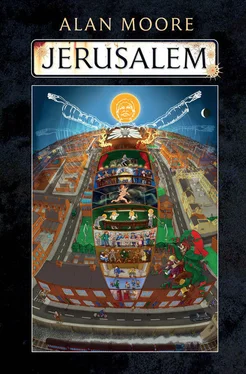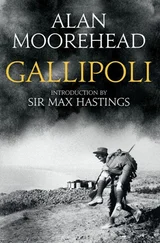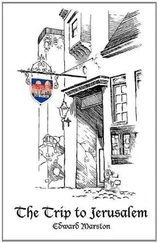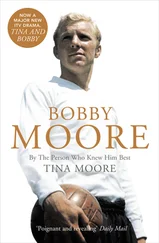Huddling amongst the birds as if they had themselves just flown down from unfriendly skies to roost in the cathedral eaves were stone apostles, with St. Paul himself perched on the portico’s high ridge and gathering his sculpted robes up round him to prevent them trailing in the grime and wet. At the far right of the most southern tower sat a disciple, Ern had no idea which one, who had his head tipped back and seemed to watch the tower’s clock intently, waiting for his shift to finish so that he could flap off home down Cheapside through the drizzle, back to Aldgate and the East. Climbing the soaked and slippery steps with fresh spots drumming on his hat-brim, Ernest had to chuckle at the irreligious notion of the statues intermittently producing liquid marble stools, Saints’-droppings that embittered parish workers would be paid to scrape away. Taking a last peer at the boiling mass of bruised cloud overhead before he slipped between the leftmost pillars and towards the north aisle entrance, he concluded that the rain was getting worse if anything, and that today he would undoubtedly be better off indoors. Stamping his boots and shaking off his sodden jacket as he crossed the threshold into the cathedral he heard the first muffled drum-roll of approaching thunder off at the horizon’s rim, confirming his suspicion.
In comparison to the October torrent pouring down outside, St. Paul’s was warm and Ern felt briefly guilty at the thought of Anne and their two children drawn up shivering to the deficient fire back home in East Street. Ernest walked along the North Aisle under the suspicious frowns of passing clergy towards the construction and activity at its far end, only remembering to snatch his sopping bonnet off at the last minute and to carry it before him humbly in both hands. With every ringing step he felt the vistas and the hidden volumes of the stupefying edifice unfolding up above him and upon all sides, as he veered from the north aisle’s curved recesses on his left and passed between the building’s great supporting columns to the nave.
Framed by St. Paul’s huge piers there in the central transept space beneath the dome milled labourers like Ern himself, their scruffy coats and britches a dull autumn palette of dust greys and browns, shabby against the richness of the paintings hung around them, the composure of the monuments and statues. Some of them were lads Ern knew of old, which was the way he’d come by this appreciated stint of paid work in the first place, with a word put in to them as were contracted for the cleaning and restoring. Men were scrubbing with soft cloths at lavishly-carved choir-stalls bossed with grapes and roses at the far end of the quire, while in the spandrels between arches underneath the railed hoop of the Whispering Gallery above were other fellows, giving the mosaic prophets and four Gospel-makers something of a wash and brush-up. Most of the endeavour though, it seemed to Ern, was centred on the mechanism overshadowing the nearly hundred-foot-wide area immediately below the yawning dome. It was perhaps the most ingenious thing that Ern had ever seen.
Hanging from the top centre of the dome, fixed to the crowning lantern’s underside at what Ern guessed must be the strongest point of the vast structure, itself with a tonnage in the tens of thousands, was a plumb-straight central spindle more then twenty storeys high that had on one side an assemblage nearly as tall made of poles and planks, while on the other side what had to have been London’s largest sandbag hung from a gigantic crossbeam as a counterweight. The sack sagged from a hawser on the left, while to Ern’s right the heavy rope-hung framework that it balanced out was shaped like an enormous pie-slice with its narrow end towards the centre where it joined securely with the upright central axis. This impressive scaffolding contained a roughly quarter-circle wedge of flooring that could be winched up and down by pulleys at its corners, so as to reach surfaces that needed work at any level of the dome. The mast-like central pivot was hung almost to the decorative solar compass in the middle of the transept floor, with what looked like a smaller version of a horizontal mill-wheel at its bottom by which means the whole creaking arrangement could be manually rotated to attend each vaulted quadrant in its turn. The pulley-hoisted platform in the midst of its supporting struts and girders was where Ern would be employed for the remainder of the day, all being well.
A fat pearl cylinder of failing daylight coloured by the worsening storm outside dropped from the windows of the Whispering Gallery to the cathedral’s flooring down below, dust lifted by the bustling industry caught up as a suspension in its filmy shaft. The soft illumination filtering from overhead rendered the workmen with a Conté crayon warmth and grain as they bent diligently to their various enterprises. Ern stood almost mesmerised admiring this effect when to the right ahead of him, out of the south aisle and its stairs from the triforium gallery above there came a striding, rotund figure that he recognised, who called to him by name.
“Oi, Ginger. Ginger Vernall. Over here, you silly beggar.”
It was Billy Mabbutt, who Ern knew from different pubs in Kennington and Lambeth and who’d landed him this opportunity to earn a bit of money, like a good ’un. His complexion florid to the point of looking lately cooked, Bill Mabbutt was a heartening sight with his remaining sandy hair a half-mast curtain draped behind his ears around the rear of that bald cherry pate, the braces of his trousers stretched across a button-collared shirt with sleeves rolled boldly back to show his ham-hock forearms. These were pumping energetically beside him like the pistons of a locomotive as he barrelled towards Ern, weaving between the other labourers who drifted back and forth through rustling, echoing acoustics on their disparate errands. Smiling at the pleasure that he always felt on meeting Billy mingled with relief that this much-needed job had not turned out to be a false alarm, Ernest began to walk in the direction of his old acquaintance, meeting him halfway. The high lilt of Bill’s voice always surprised Ern, coming as it did from those boiled bacon features, lined with sixty years and two campaigns — in Burma and Crimea — with this last being the place the two had met. The older man, who’d been a quartermaster, had adopted what appeared to be the shot-and-shell repellent Ernie as his red-haired lucky charm.
“Gor, blow me, Ginger, you’re a sight for sore eyes. I was upstairs in the Whispering Gallery just now, looking at all the work there is to do and getting in a right commotion ’cause I swore blind as you’d not show up, but now you’ve come and made me out a liar.”
“Hello, Bill. I’ve not got ’ere too late, then?”
Mabbutt shook his head and gestured in between the hulking piers to where a gang of men were struggling as they adjusted the immense contraption there at the cathedral’s heart, dependent from its dome.
“No, you’re all right, boy. It’s the mobile gantry what’s been messing us about. All over everywhere, she was, so if you’d got ’ere sooner you’d have only been sat on your ’ands. I reckon as we’ve got ’er settled now, though, by the looks of things, so if you want to come across we’ll get you started.”
One fat and the other thin, one with a pale complexion and red hair, the other with its opposite, the two men sauntered down the nave, over the resonant and gleaming tiles, and passed between its final columns to where all the work was going on. As they drew nearer to the dangling monster that Bill had referred to as the mobile gantry, Ern revised with each fresh pace his estimate regarding the thing’s size. Close to, that twenty floors of scaffolding was more like thirty, from which he inferred that he’d be at his job two or three hundred feet above the ground, a disconcerting prospect even given Ernest’s celebrated head for heights.
Читать дальше












